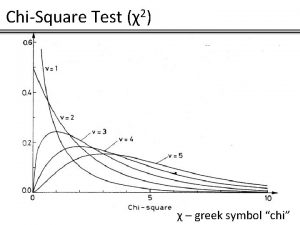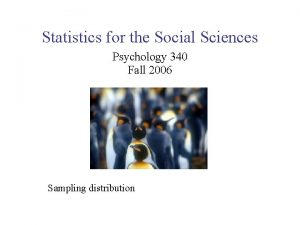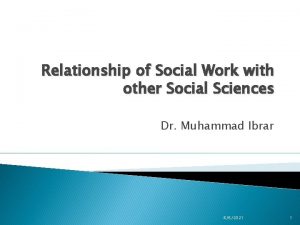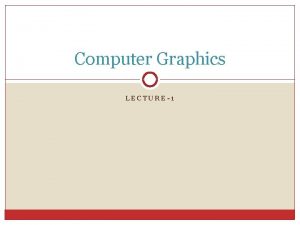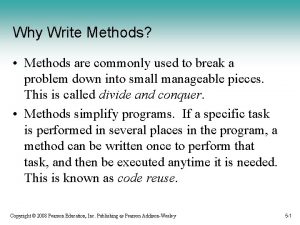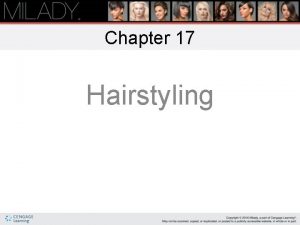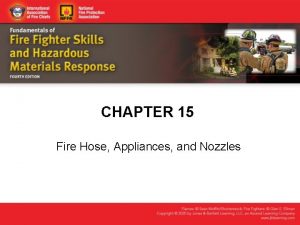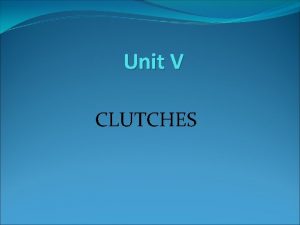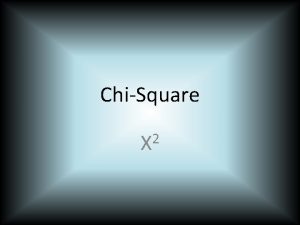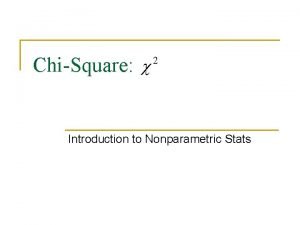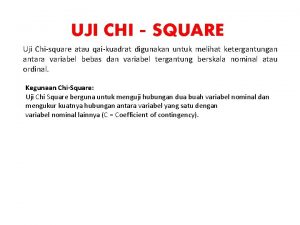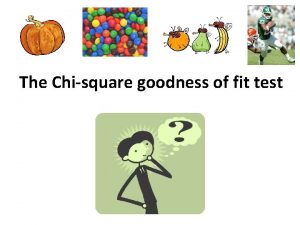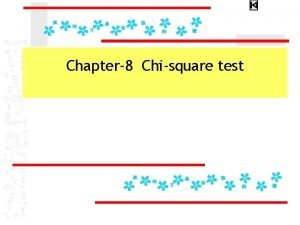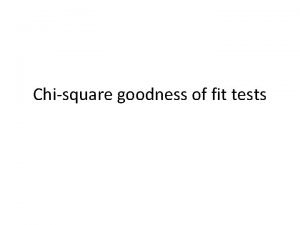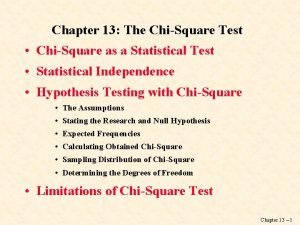Commonly Used Statistics in the Social Sciences Chisquare












- Slides: 12

Commonly Used Statistics in the Social Sciences Chi-square Correlation Multiple Regression T-tests ANOVAs

Chi-square 2 ( ) Used with nominal scale data n n n Frequency data: number of participants who fall in each of several categories Can be used with experimental or correlational method Examines the extent to which the frequencies that are observed in your study differ from the expected frequencies. Example n n Null hypo: There is no relationship between sex and hand dominance. Alt hypo: There is a relationship between sex and hand dominance. 2 (1, n = 100) = 34. 55, p<. 01

Correlation Measures the degree and direction of linear relationship between 2 variables w Closer to 1 or – 1 means stronger relationship w Positive value indicates positive relationship, negative value is negative relationship The Pearson Correlation Coefficient (r) n n Used when data is interval or ratio (IQ and height) r (98) =. 44, p<. 05 Alternative correlation are used when: w Both variables are dichotomous (Gender & Handedness) w One variable is continuous and one is dichotomous (Gender and IQ) w Both variables are ordinal (ranked color preference and ranked music preference)

Positive Correlations As one variable goes up the other one goes up as well STRONG (r = 1. 0) WEAKER ( r=. 60)

Negative Correlations As one variable goes up the other one goes DOWN STRONG (r = -1. 0) WEAKER ( r= -. 60)

Multiple Regression Used to examine the relationship between two or more predictor variables (IVs) and a criterion variable (DV). Example: n n Predictor variables: Gender and Age Criterion variable: Income Multiple regression allows us to control for the effect of 1 IV when examining effects of another Beta weight: n n Standardized units showing the effect of each IV on the DV when all IVs are in the equation. =. 22, p <. 05; =. 42, p <. 01

T-test Used to examine if 2 groups are significantly different from each other w The DV must have been measured on either interval or ratio scales w Can use with between subjects groups (independent samples ttest) or within subjects groups (paired sample t-test) Example: n Null hypo: w People with brain injuries in the right cerebral hemisphere perform just as well on a standardized spatial skills task as noninjured people. n Alternative hypo: w People with brain injuries perform worse than non-injured people. n t (48) = 10. 15, p <. 05

Analysis of Variance (ANOVA) Used to determine whethere is a significant difference between groups that have been measured on either interval or ratio scales n n Can be used with between, within, or mixed designs! Can be used with 1 or more IVs.

One-way ANOVA 1 independent variable: n Physical distance and self-disclosure w IV: Distance of interviewer: Near or far w DV: Number of disclosing statements made n ANOVA results w Tell us if distance had an effect n Look at means to see what the effect was w F (1, 60) = 14. 55, p<. 05

One-way ANOVA 1 independent variable: n More than 2 levels w Lets say IV had 3 levels: Near, Medium, Far w Can still use the ANOVA! n ANOVA results w Tell us if distance had an effect w F (2, 60) = 14. 55, p<. 05) w But we don’t know exactly where the differences lie

Concept Check A researcher gives some participants alcohol and others an alcohol-like placebo. She then measures their performance on a driving simulation. What statistical test should she use to determine if the participants given alcohol drove worse?

Two-way ANOVA 2 Independent Variables (Two way ANOVA): n Intelligence and teaching method on academic performance w IVs: n n Intelligence: Low and High Teaching method: Traditional or new w DV: Exam performance n ANOVA results: w Main effect of intelligence: Was test performance affected by students intelligence? (F (1, 32) = 7. 55, p<. 05) w Main effect of teaching style: Was test performance affected by teaching style? (F (1, 32) = 8. 12, p<. 05) w Interaction: Was the effect of teaching style dependent on the students intelligence? (F (1, 32) = 9. 32, p<. 05)
 Expected frequency symbol
Expected frequency symbol Statistics for social sciences
Statistics for social sciences Natural sciences tok
Natural sciences tok Social work and other social sciences
Social work and other social sciences Section lines example
Section lines example List three of the commonly used assembly constraints
List three of the commonly used assembly constraints Computer graphics models are now commonly used for making
Computer graphics models are now commonly used for making Methods are commonly used to
Methods are commonly used to Name and describe the three types of hair presses.
Name and describe the three types of hair presses. Hose appliances
Hose appliances The commonly used angle between leather or asbestos
The commonly used angle between leather or asbestos What effect might alcohol and another drug
What effect might alcohol and another drug Radial line development examples
Radial line development examples
